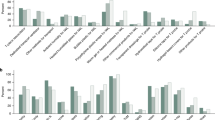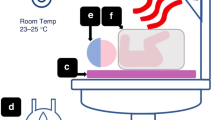Abstract
Objective
Increase the percentage of transported preterm or LBW infants with an admission temperature of 36.5–37.5 °C from 60 to 80% by December 2017.
Study design
We used the Model for Improvement with Plan-Do-Study-Act (PDSA) cycles. Interventions focused on awareness of temperature control in preterm infants, adequate monitoring, and maintaining normothermia. Interventions consisted of standardizing isolette temperature, use of chemical warming pack and plastic wrap, and feedback. Data were plotted on a p-chart and grouped by month.
Result
A total of 381 infants <37 weeks or <2.5 kg were transported from January 2016 to December 2019. At baseline 60% were admitted with a temperature within the range of 36.5–37.5 °C. Special cause variation was noted twice during the study period, initially to 80% in June 2018 and then to 96% in April 2019, without an increase in hyperthermia.
Conclusion
Multidisciplinary quality improvement efforts improved normothermia in vulnerable transported infants to 96%.
This is a preview of subscription content, access via your institution
Access options
Subscribe to this journal
Receive 12 print issues and online access
$259.00 per year
only $21.58 per issue
Buy this article
- Purchase on Springer Link
- Instant access to full article PDF
Prices may be subject to local taxes which are calculated during checkout






Similar content being viewed by others
References
Costeloe K, Hennessy E, Gibson AT, Marlow N, Wilkinson AR. The EPICure study: outcomes to discharge from hospital for infants born at the threshold of viability. Pediatrics. 2000;106:659–71.
Laptook AR, Salhab W, Bhaskar B, Network NR. Admission temperature of low birth weight infants: predictors and associated morbidities. Pediatrics. 2007;119:e643–9.
Miller SS, Lee HC, Gould JB. Hypothermia in very low birth weight infants: distribution, risk factors and outcomes. J Perinatol. 2011;31:S49–56.
Martin RJ, Fanaroff AA, Walsh MC. Fanaroff and Martin’s neonatal-perinatal medicine: diseases of the fetus and infant. 10th ed. Philadelphia, PA: Elsevier/Saunders; 2015. xxiv, 833 pages (I1-I65 pages) p.
Chang HY, Sung YH, Wang SM, Lung HL, Chang JH, Hsu CH, et al. Short- and long-term outcomes in very low birth weight infants with admission hypothermia. PLoS One. 2015;10:e0131976.
Russo A, McCready M, Torres L, Theuriere C, Venturini S, Spaight M, et al. Reducing hypothermia in preterm infants following delivery. Pediatrics. 2014;133:e1055–62.
McNellis EM, Leonard AR, Thornton KA, Voos KC. Improving thermal support in very and extremely low birth weight infants during interfacility transport. Pediatr Qual Saf. 2019;4:e170.
Leng H, Wang H, Lin B, Cheng G, Wang L. Reducing transitional hypothermia in outborn very low birth weight infants. Neonatology 2016;109:31–6.
Knobel R, Holditch-Davis D. Thermoregulation and heat loss prevention after birth and during neonatal intensive-care unit stabilization of extremely low-birthweight infants. Adv Neonatal Care. 2010;10:S7–14.
McCall EM, Alderdice F, Halliday HL, Jenkins JG, Vohra S. Interventions to prevent hypothermia at birth in preterm and/or low birthweight infants. Cochrane Database Syst Rev. 2010:CD004210. https://doi.org/10.1002/14651858.CD004210.pub4.
Pinheiro JM, Furdon SA, Boynton S, Dugan R, Reu-Donlon C, Jensen S. Decreasing hypothermia during delivery room stabilization of preterm neonates. Pediatrics. 2014;133:e218–26.
Chien LY, Whyte R, Aziz K, Thiessen P, Matthew D, Lee SK, et al. Improved outcome of preterm infants when delivered in tertiary care centers. Obstet Gynecol. 2001;98:247–52.
Knobel RB, Vohra S, Lehmann CU. Heat loss prevention in the delivery room for preterm infants: a national survey of newborn intensive care units. J Perinatol. 2005;25:514–8.
Harris PA, Taylor R, Thielke R, Payne J, Gonzalez N, Conde JG. Research electronic data capture (REDCap)–a metadata-driven methodology and workflow process for providing translational research informatics support. J Biomed Inf. 2009;42:377–81.
Harris PA, Taylor R, Minor BL, Elliott V, Fernandez M, O’Neal L, et al. The REDCap consortium: Building an international community of software platform partners. J Biomed Inf. 2019;95:103208.
Lunze K, Bloom DE, Jamison DT, Hamer DH. The global burden of neonatal hypothermia: systematic review of a major challenge for newborn survival. BMC Med. 2013;11:24.
Lunze K, Hamer DH. Thermal protection of the newborn in resource-limited environments. J Perinatol. 2012;32:317–24.
Belsches TC, Tilly AE, Miller TR, Kambeyanda RH, Leadford A, Manasyan A, et al. Randomized trial of plastic bags to prevent term neonatal hypothermia in a resource-poor setting. Pediatrics. 2013;132:e656–61.
World Health Organization MaNHSM. Thermal protection of the newborn: a practical guide. In: Geneva: Maternal and Newborn Health/Safe Motherhood Unit DoRHTS, World Health Organization 1997.
Acknowledgements
We acknowledge the critical care transport team members who were essential to this quality improvement effort, as well as the NICU staff who supported the project. We also acknowledge the caregivers at outlying hospitals who contributed to improvement efforts in thermoregulation for preterm infants prior to the arrival of the critical care transport team. We especially acknowledge the crucial work of Dr. Melanie Stempowski, MD; Deb Skoglund, RN, MSN; Susan Dornan, RN; and Dr. Ganga Srinivas, MD; in actualizing the interventions within the context of individual hospitals.
Funding
Support for REDCap (Research Electronic Data Capture) Provided by: CTSC grant (1 UL1 RR024989 from NCRR/NIH)
Author information
Authors and Affiliations
Contributions
TG conceptualized the project, collected data, planned interventions, evaluated the success of each PDSA cycle, and drafted and revised the final manuscript. RP assisted with implementing interventions, providing feedback on each intervention, evaluated all data points outside of goal range, and revised the final manuscript. LC assisted with data collection, planning and assessing interventions, and revised the final manuscript. GY supervised the project, assisted with planning the initial project, assisted with planning and assessing interventions, and revised the final manuscript.
Corresponding author
Ethics declarations
Conflict of interest
The authors declare that they have no conflict of interest.
Additional information
Publisher’s note Springer Nature remains neutral with regard to jurisdictional claims in published maps and institutional affiliations.
Rights and permissions
About this article
Cite this article
Glenn, T., Price, R., Culbertson, L. et al. Improving thermoregulation in transported preterm infants: a quality improvement initiative. J Perinatol 41, 339–345 (2021). https://doi.org/10.1038/s41372-020-0732-z
Received:
Revised:
Accepted:
Published:
Issue Date:
DOI: https://doi.org/10.1038/s41372-020-0732-z
This article is cited by
-
Development, implementation, and evaluation of neonatal thermoregulation decision support web application
BMC Medical Informatics and Decision Making (2023)



